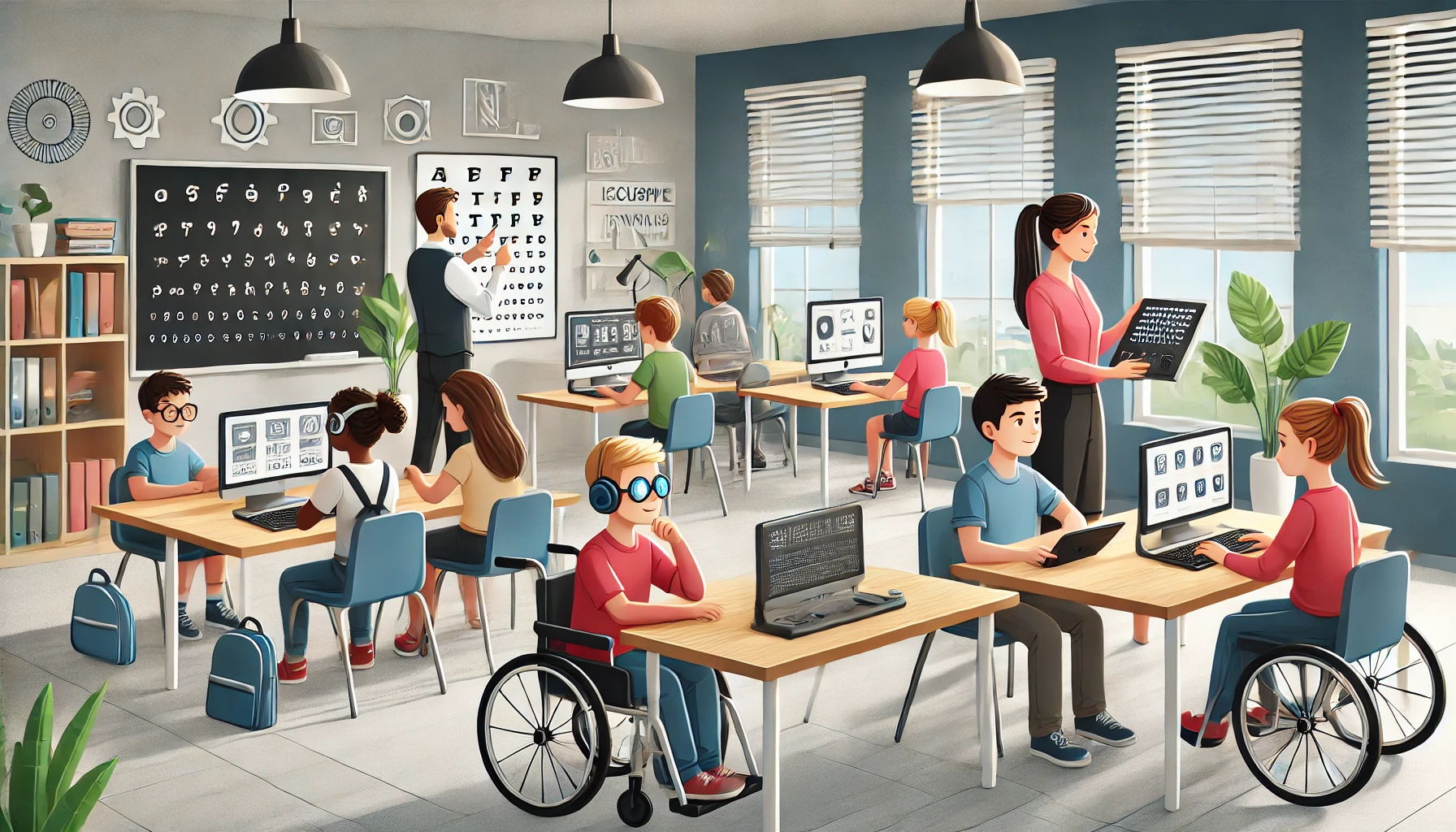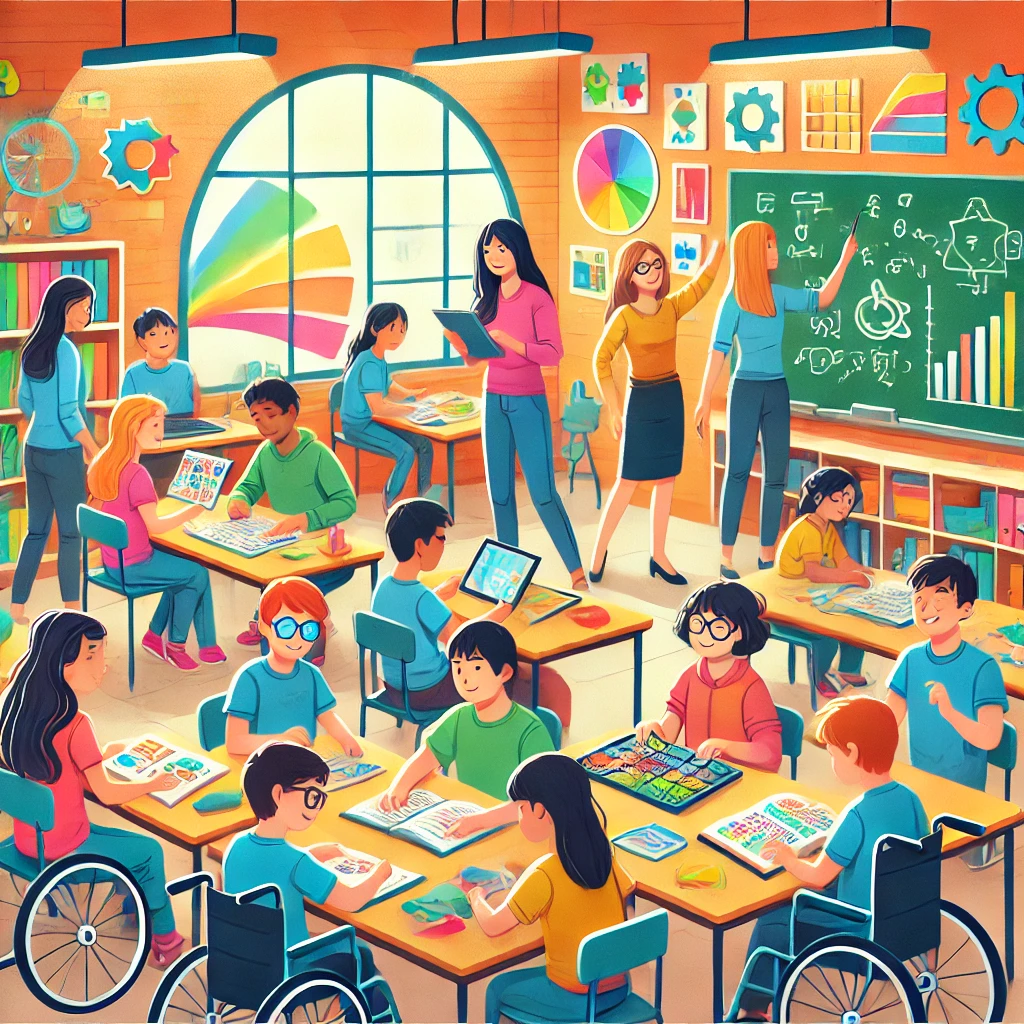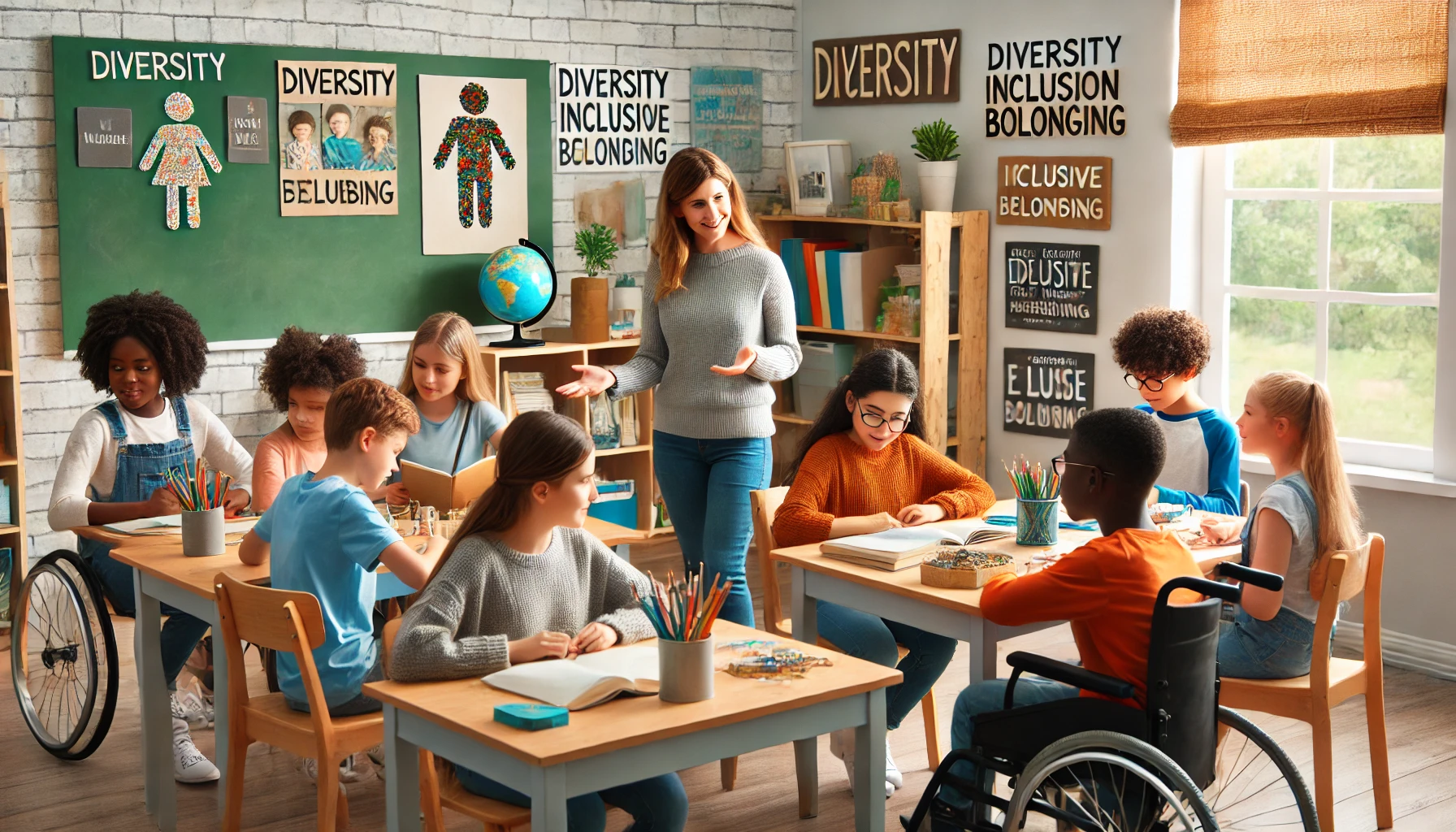Understanding Inclusive Education
Okay, let’s chat about inclusive education for students with disabilities. I’m talking about the nuts and bolts, the whys and hows, and everything in between.
Definition and Goals
So what’s the deal with inclusive education? Simply put, it’s about making sure that students with disabilities get a fair go by integrating them into the same classrooms as everyone else. The big picture here is about creating a learning space where diversity rules, acceptance thrives, and every student gets access to the same stuff, no matter their abilities.
Now, making this happen isn’t just about a change of seats. It’s about catering to how each student learns best, tossing in the right support services, and making everyone feel they’re an important part of the school fam. Schools that truly embrace inclusivity and equity give students with disabilities the tools they need to shine both academically and socially.

Benefits and Challenges
Yes, inclusive education has its quirks, but there’s a truckload of good stuff that comes with it:
- Boosting Academic Growth: This approach backs academic development by tailoring how learning happens and throwing in support services that cater to the unique learning needs of students with disabilities. With inclusivity in the classroom, educators can help kids hit their academic stride.
- Encouraging Social Skills: Who doesn’t want recess buddies? Inclusive education encourages friendships and teamwork across differing abilities. Students with disabilities interact with peers, picking up key social skills, making new friends, and feeling like they truly belong in the school crowd.
But hey, it’s not all smooth sailing. Getting inclusive education right means dealing with a bunch of hurdles like teacher training, jazzy learning materials that everyone can use, rethinking school facilities, tackling stigma, and making sure policies stick to global rights standards (UNICEF). Taking down these hurdles demands a team effort from everyone to make sure students with disabilities not only learn but flourish in the classroom.
As we push forward with inclusive education, it’s vital to understand why creating such an environment matters—valuing diversity, ensuring equal educational opportunities, and enabling students with disabilities to smash their goals. By building an inclusive education system, we pave the way toward a more just society where every kid gets a fair shot at learning, growing, and shining bright.
Importance of Inclusive Education
When we think about how big a deal inclusive education is for students with disabilities, it’s clear as day that this way of doing things really makes a difference in both hitting those academic goals and getting involved with others. It’s helpful for parents, teachers, and caregivers to understand how influential inclusive education can really be for kids with special needs.
Promoting Academic Achievement
Taking on the ideas behind inclusive education has been shown to give students with disabilities a boost in their academic performance. Back in 2001, there was a study that showed students with disabilities actually made better progress in math when they were in regular classes, compared to being in separate ones. And it wasn’t just the kids with disabilities who got better; their classmates did too, with everyone making bigger strides in math (University of San Diego).
With inclusive education, students with disabilities get to learn with their buddies, leading to better talking skills, making new pals, and academic progress. The teamwork in these classrooms not only helps students learn from each other but also makes the learning environment one where each student, no matter their ability, can shine.
Fostering Social Interaction
Inclusive education does more than just help with grades; it also brings kids together socially. Mixing students with and without disabilities in one classroom helps promote kindness, understanding, and acceptance. Everyone gets to know and value diversity, build solid friendships, and feel like they belong in the school scene.
Research shows that students with disabilities who learn inclusively gain better social skills, act up less, and even attend school more regularly. These positive social strikes lead to a school environment where everyone counts and is cheered on for what they uniquely bring to the table.
Having schools that nurture both academic growth and social skills sets up kids for triumph not just in school, but in life. By boosting inclusive education, we make sure everyone gets a fair chance to learn and grow, setting a bright path toward an all-embracing future for all.
Implementing Inclusive Education
Tackling the challenge of weaving inclusive education into the fabric of our schools isn’t always a walk in the park, but that’s where the magic happens—learning and growing alongside each student’s unique needs. It’s about setting up a learning space where everyone, especially students with disabilities, can thrive and shine in their own way.
Overcoming Barriers
Making inclusive education a reality calls for a fresh look at all levels of society—kind of like giving a house a makeover. We start with training teachers to think and teach inclusively, reshaping classrooms so accessibility is not just a buzzword, and filling shelves with materials that speak to everyone’s needs. Tackling the stigma head-on and rewriting old laws to match up with global standards like the Rights of Persons with Disabilities. We also need to keep tabs on what works and what doesn’t, using a magnifying glass on data to keep improving how kids get what they need (UNICEF).
One of the big mountains to climb is getting the right training for teachers—especially with all the cool assistive technologies that can help in the classroom. A study found a huge chunk of folks, nearly three out of four, saying that beefing up teacher training could really make these tech tools shine in schools. To clear the path, we need to have ongoing support and learning for teachers so everyone, especially kids with disabilities, gets the right help.
Strategies for Success
You can’t build a solid house without a good plan, and the same goes for inclusive education. One big nugget of wisdom is weaving in assistive technology—these gadgets and programs are like superheroes for students, swooping in to lessen their reliance on others for things like reading or writing. Cool tools like concept mapping software, spell checkers, and word predictors don’t just lessen the load; they are game-changers that boost academic success (LDAtschool).
Assistive technology isn’t a magic wand that makes learning difficulties disappear, but man, it sure helps kiddos work with their strengths and tackle their challenges in a big way (Reading Rockets).
Another winning play is inclusive classrooms. Think of it as teamwork at its best, where special educators join forces with general educators right in the hustle and bustle of the classroom, instead of separating kids out for special instruction. This team-up gives everyone, not just those with challenges, an extra boost of resources and support, paving the way for better results all around (University of San Diego).
It’s all about knocking down barriers and using smart strategies to build a school environment where everybody counts. When educators and caregivers make this a priority, they foster a diverse and equal world where every student can grow academically, socially, and emotionally—because everyone deserves a chance to hit a homerun in education.
Role of Technology in Inclusive Education
Technology’s like the magic in inclusive education, helping students with disabilities find their groove in learning spaces. Now, let’s get into the good stuff: what’s out there in assistive tech and the bumps we hit when trying to use it.

Assistive Technology Overview
Think of assistive technology as your toolbox filled with gadgets and gizmos that give students with disabilities a little boost. You’ve got everything from super basic pencil grips to fancy software that turns text into speech or lets you speak into a computer to get your words on the screen. There are even tools that guess what word you’re about to type next, almost like they’re reading your mind.
These gadgets can help students get things done on their own, whether it’s cracking open a book, jotting down an essay, or keeping their stuff in order. With cool strategies, programs that help map out ideas, and spelling and word-guessing features, students can get better at writing and rewriting, building independence one keystroke at a time.
There’s a tool for just about any learning hiccup a student might have. Whether it’s getting better at listening, organizing thoughts, remembering stuff, crunching numbers, or making sense of what they’re reading – assistive tech is like a trusted sidekick, improving school performance (Reading Rockets).
| AT Tools | Description |
|---|---|
| Audiobooks | Help turn the pages with your ears |
| Electronic math worksheets | Do some heavy lifting on math problems |
| Information/data managers | Keep details from scattering everywhere |
| Optical character recognition | Speed up your reading game |
| Proofreading programs | Keep written work in check |
| Speech-recognition programs | Get what you say on the page |
| Talking calculators | Give a voice to numbers |
Challenges in Implementation
Even with all this high-tech help, bringing assistive tech into classrooms isn’t always sunshine and rainbows. Some common stumbling blocks include everyone not seeing eye-to-eye, teachers lacking proper training, not enough help available, tight budgets making it hard to buy the latest tech, and teachers just not having enough time to fit it all in.
Training teachers up to snuff is key. They’re the ones who can make using these tools a reality in everyday school life. Research shows that better training for staff is essential for rolling out tech in schools (LDAtschool). By getting educators familiar with these technologies and offering continuous support, schools can turn into cozy corners where every student and their unique needs get the attention they deserve.
When we get tech into classrooms and iron out the bumps, everyone—teachers, parents, and caregivers alike—can jump in to make learning spaces more friendly and supportive for kids with disabilities.
Global Perspective on Inclusive Education
So, what’s the scoop with inclusive education for students with disabilities? Well, take a peek at the global picture, and you’ll see how it shapes up initiatives aimed at leveling the playing field for everyone. By digging into what’s been done so far, we can get a feel for the roadblocks—and the victories—along the way, with big names like UNICEF leading the charge.
What’s Happening
UNICEF throws us some staggering numbers: about 240 million kids with disabilities around the globe face some pretty gnarly obstacles to education, often landing them out of school. It’s like they’re stuck in a game of bureaucratic Whack-a-Mole, dealing with tons of discrimination and missing the boat on tailored school services. To tackle this worldwide snag, folks have been rolling out plans to champion inclusive education.
Making schools inclusive isn’t just flipping a switch—there are layers to it. We’re talking teacher training, tweaking school layouts, whipping up easy-to-get learning materials, battling stigma, syncing laws with disability rights, and crunching numbers to make sure services hit the mark.
UNICEF Gets Involved
UNICEF’s been key in backing governments to launch and keep tabs on inclusive education programs that aim to bridge the educational divide for disabled kids. They focus on four main game-changers to ensure every kid gets a fair shot at learning:
- Teacher Know-How: They fund training so teachers can handle diverse classrooms like pros and meet all sorts of learning needs.
- School Setup: They push for schools to redo their buildings to welcome all students, disabilities and all.
- Learning Gear: They make sure learning resources get a makeover to fit different learning styles and needs.
- Battling Bias: They work to scrub away stigma and discrimination right in the communities, creating spaces where all kids feel they belong.
By rallying together with governments and other big players, UNICEF is driving the conversation on inclusive education. They’re backing efforts to give every child the tools they need to learn and grow, no matter what. By spotlighting equality in education, UNICEF plays a crucial role in building a society where every kid gets a fair chance to shine.
Advancing Inclusive Education
I’m all about leveling the playing field for students with disabilities through inclusive education, focusing on things like Sustainable Development Goals and making sure everyone gets a fair shot. These big themes help shape how education should work for folks with all kinds of needs.

Sustainable Development Goals
Back in 2015, folks got together to lay down the Sustainable Development Goals (SDGs). They’re basically a big plan to make sure people with disabilities aren’t left out of schools. Goal 4 is a standout—it’s all about making sure everyone, no matter their abilities, can hit the books and get job training by 2030. The whole idea is to level up educational opportunities for everyone and make learning spaces that are fair and open.
Promoting Equal Access
Getting everyone into the classroom isn’t just about checking boxes—it’s about equal footing for students with disabilities. The United Nations Convention on the Rights of Persons with Disabilities (CRPD) turned the tables, saying hey, disability is about rights, not just medical stuff. It’s a huge deal that 173 countries signed this, saying every kid deserves a seat in an inclusive classroom with all the support they need to grow.
Taking cues from the Salamanca Framework for Action, there’s a push for inclusive education to be the go-to. This setup means rolling everyone into the same schools, where varied needs are part of the everyday environment. Schools should play to everyone’s strengths and tackle their challenges head-on. When countries weave inclusive practices into their education strategies, they make schools better for all students.
Goal 4 in those SDGs really hammers home the need for everybody to get quality education. By focusing on giving everyone a fair shake in education and setting up safe, non-discriminatory spaces, it turns the dream of empowerment into reality for diverse learners. To make it all happen, there’s a lot to do—training teachers, sprucing up infrastructure, making learning materials accessible, working with communities to fight stereotypes, syncing national laws with global standards, and making decisions based on solid data to actually help students with disabilities.
Pushing forward with inclusive education by sticking to these Sustainable Development Goals and ensuring equal access isn’t just nice—it’s necessary. It’s about crafting an environment where every student feels supported and valued. By believing in these goals and bringing them to life, we pave the path for a future where every learner gets to shine, no matter their backstory or abilities.






